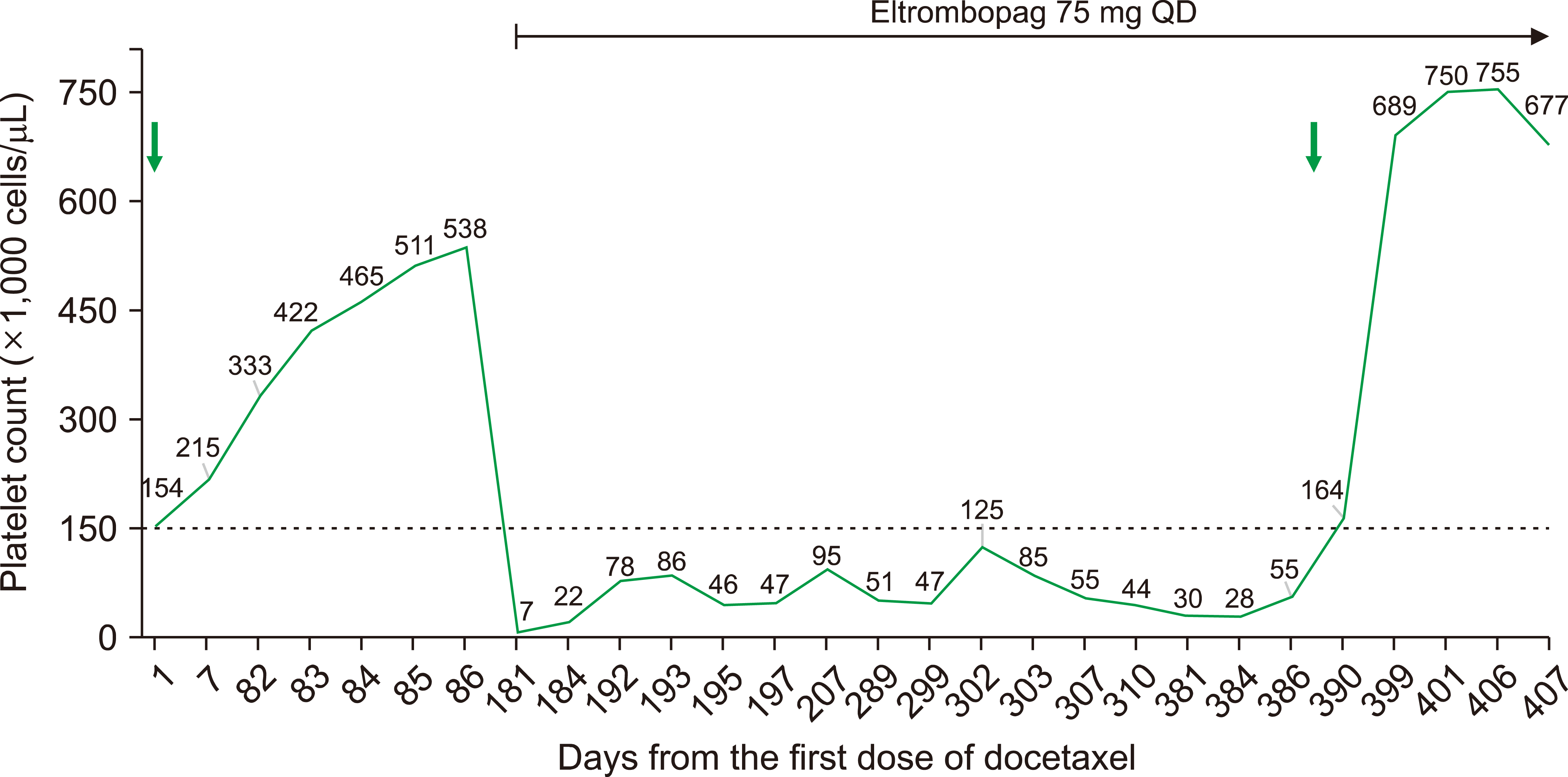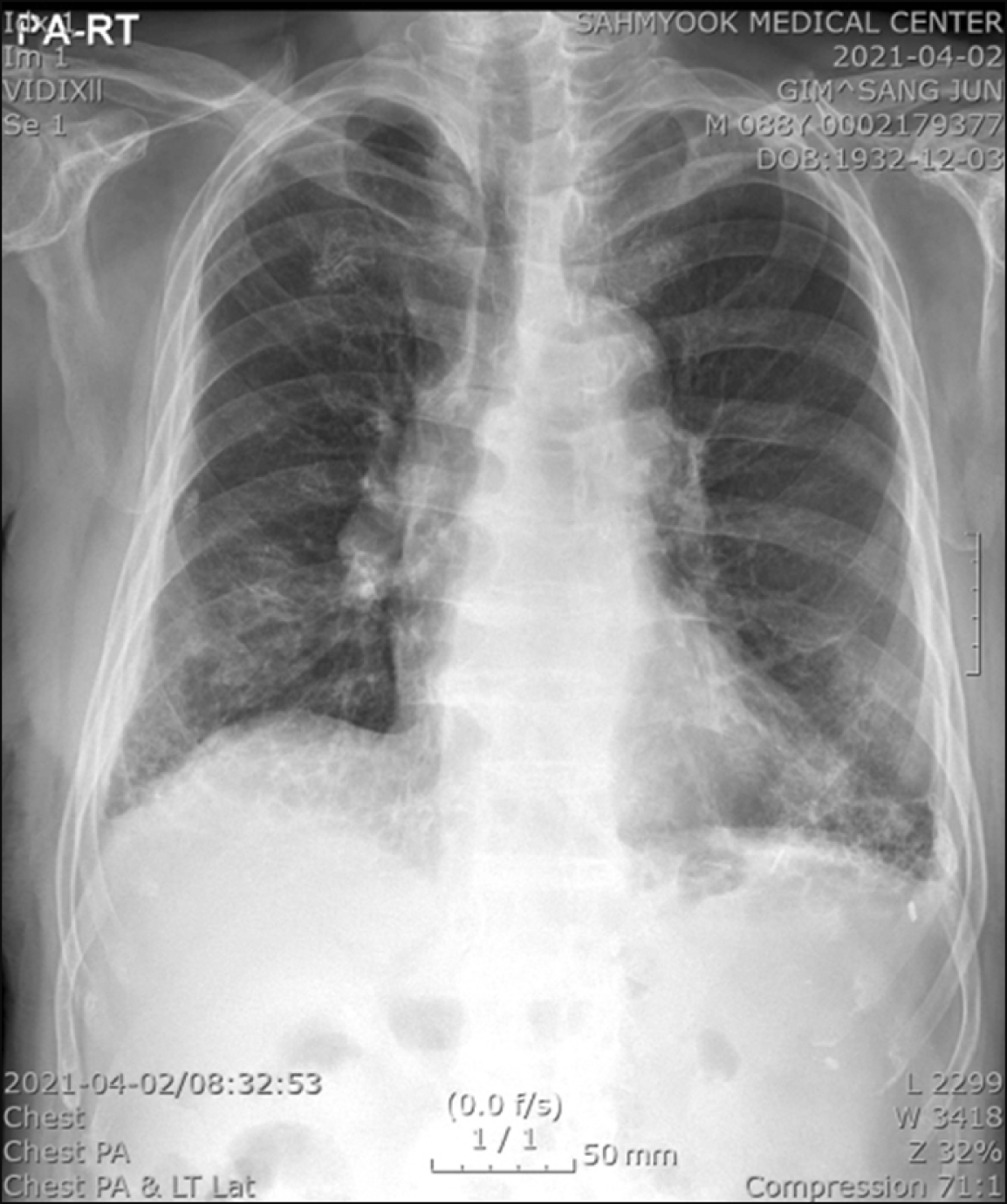TO THE EDITOR: Coronavirus disease (COVID-19) was confirmed in an 88-year-old man on March 8, 2021 by reverse transcription–polymerase chain reaction (RT-PCR) for severe acute respiratory syndrome coronavirus 2 (SARS CoV-2) RNA, when he was admitted for exertional dyspnea of vague onset with no fever, cough, or phlegm. His medical history revealed refractory/recurrent immune thrombocytopenic purpura (ITP) to high-dose immunoglobulin, immunosuppressive therapy including dexamethasone, vincristine, and cyclophosphamide, and splenectomy. He was treated with 25 mg eltrombopag, once a day (QD), in September 2020. A diagnosis of advanced prostate adenocarcinoma was made in May 2016, which was well controlled with androgen blockade until February 23, 2021, when 80 mg docetaxel was administered for tumor pro-gression (Fig. 1). In April 2016, idiopathic pulmonary fibrosis was diagnosed. Additionally, hypertension and diabetes were diagnosed in April 2016 and treated with amlodipine 5 mg QD plus hydrochlorthaizide 25 mg QD and teneligliptin 10 mg QD plus metformin 500 mg QD, respectively. He underwent laparoscopic cholecystectomy in November 2017 for gallbladder stones and endoscopic sphincterotomy for common bile duct stone in October 2019, and bilateral gonarthrosis was diagnosed in 1990. His family history was unremarkable. He had not been vaccinated against COVID-19. Physical examination findings were unremarkable, with no fever, pallor, jaundice, lymphadenopathy, or bleeding tendency, except for bibasilar crackles and multiple abdominal surgical scars. The dyspnea experienced by the patient was attributed partly to two-vessel coronary arterial obstructive disease diagnosed by angiography and echocardiography in February 2021 and to COVID-19 to some extent. The patient did not develop pneumonia (Fig. 2). Further treatment with docetaxel was discontinued. Approximately 6 weeks after the first dose of docetaxel or 4 weeks after contracting COVID-19, sudden severe thrombocytopenia (7,000/μL) was recorded on April 2, 2021 (Fig. 1). This was despite the patient complying with the prescribed treatment of 25 mg eltrombopag QD, with no overt bleeding tendency or evidence of sepsis, disseminated intravascular coagulation (DIC), hemophagocytic lymphohistiocytosis (HLH), or thrombotic thrombocytopenic purpura (TTP) on anamnesis, physical examination, and laboratory tests. Laboratory findings were as follows: hemoglobin, 13.3 g/dL; white blood cells count, 11,300/μL (64% neutrophils and 22% lymphocytes); lactate dehydrogenase, 283 IU/L (reference value, 135–225 IU/L); and d-dimer, 0.53 μg/mL (reference value <0.5 μg/mL). The test results for Campylobacter-like organisms were negative. The eltrombopag dose was increased to 75 mg QD (Fig. 1), but platelet concentrate transfusion or corticosteroids administration was not performed. The elevated platelet count was in the range of 22,000–125,000/μL between April 5, 2021 and June 7, 2021. RT-PCR for SARS CoV-2 was negative on April 13, 2021. The second dose of docetaxel 80 mg was administered on June 9, 2021 (Fig. 1), 15 weeks after the first dose, with continuous administration of eltrom-bopag at 75 mg QD. The platelet count was >150,000/μL on June 11, 2021, which rose to >600,000/μL on June 20, 2012 when the dose of eltrombopag was reduced to 25 mg QD.
The severity of COVID-19 in our case was graded as either asymptomatic or mild, without pneumonia development. During the clinical course of COVID-19 in this patient, there were no complications, except for the ITP relapse. The thrombocytopenia relapse on April 2, 2021 was detected about 4 weeks after COVID-19 was confirmed on March 8, 2021. There was no bleeding tendency observed. The sudden drop in the platelet count to 7,000/μL on April 2, 2021 was not considered an adverse effect of docetaxel. It was not attributed to either marrow suppression or drug-induced ITP in view of the long interval (6 weeks) between drug administration and thrombocytopenia, paradoxical rise of platelet count immediately after docetaxel administration, and the absence of bleeding tendency usually seen with drug-induced ITP. The response to the thrombopoietin receptor agonist between April 5, 2021 and June 7, 2021 was a dramatic rise in the platelet count on June 11, 2021 (Fig. 1), immediately following the administration of 80 mg of docetaxel on June 9, 2021. This was indicative of the cytotoxic effect of chemotherapy on ITP as observed on two occasions of the seven previous administrations of intermittent parenteral cyclophosphamide at 1,500 mg. On the first occasion, the platelet count of 37,000/μL on day 1 showed a remarkable rise to 88,000/μL on day 2, 109,000/μL on day 3, and 174,000/μL on day 9. On the second occasion, the platelet count was 78,000/μL on day 1, which rose to 79,000/μL on day 2, 102,000/μL on day 3, 148,000/μL on day 5, 174,000/μL on day 6, 204,000/μL on day 10, and 250,000/μL on day 13. Dose escalation of eltrombopag was performed, but high-dose immunoglobulin was not attempted despite a theoretical advantage in cases of COVID-19, as there is no survival benefit of convalescent plasma in patients with COVID-19 pneumonia [1]. Corticosteroids were withheld, as the patient did not develop pneumonia requiring respiratory support [2].
The incidence of ITP associated with COVID-19 is rare. In total, 45 cases of new-onset ITP in conjunction with COVID-19 [3] were analyzed in terms of the clinical profile and outcomes through a literature review. The diagnosis of COVID-19-associated ITP should be made meticulously [3] by excluding concomitant factors that can cause thrombocytopenia in COVID-19 patients, such as sepsis, DIC, HLH, or TTP. ITP is common in elderly patients with moderate-to-severe COVID-19 [3]. The majority of ITP cases were detected over a week after the onset of COVID-19 symptoms, and some were even detected after clinical recovery [3]. ITP among asymptomatic COVID-19 patients accounted for 7% of the total cases, underscoring the need for COVID-19 testing in newly diagnosed ITP cases, regardless of the presence of COVID-19 symptoms [3]. The worsening of ITP in our COVID-19 case did respond to dose augmentation of the thrombopoietin receptor agonist, but there were no thromboembolic events. Among a few reports of worsening ITP affected by COVID-19, this is the first case report of recurrent ITP caused by COVID-19 that was successfully managed with eltrombopag alone [4-6].




 PDF
PDF Citation
Citation Print
Print




 XML Download
XML Download